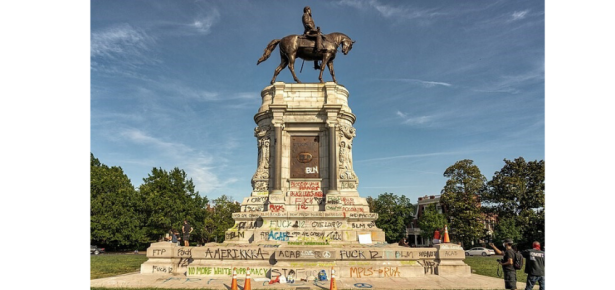
Monuments have been coming down all over the world, from Louisville, Kentucky to Bristol, England. Protestors tore President of the Confederacy Jefferson Davis from his pedestal in Richmond, Virginia, while Edward Colston, a seventeenth-century slave trader, lies at the bottom of Bristol Harbor. A Virginia court just blocked the removal of Confederate General Robert E. Lee’s statue from Richmond’s Monument Avenue for ten days.
What does the death of George Floyd have to do with Edward Colston? Why should protestors against police brutality today be tearing down or defacing monuments to Confederate generals, slave traders, and even the Belgian King Leopold, who terrorized and colonized Congo?
History matters. This has never been clearer than it is right now, when marchers for racial justice chant, “The system ain’t broke, it was built this way.” The Black Lives Matter protestors recognize that George Floyd’s death is not an anomaly, but part of a long history of brutalizing Black bodies that began in slavery. Although, as Presidential adviser Stephen Miller suggests, “a statue never prevented someone from getting an education,” the history that Confederate statues represent has had a painful legacy in the segregated and unequal education many African Americans experience to this day.
The Confederate cause was the cause of slavery. Although some conservative writers this week have claimed on social media that General Lee opposed slavery and fought only for his beloved Virginia, Lee owned human beings, sold families apart, and had his overseer beat them within an inch of their lives. Some argue that Lee and other Confederates were fighting not for slavery but for independence. As one Richmond newspaper said to that notion: “Our doctrine is this: WE ARE FIGHTING FOR INDEPENDENCE THAT OUR GREAT AND NECESSARY DOMESTIC INSTITUTION OF SLAVERY SHALL BE PRESERVED.” Confederate leaders like Lee and Davis made no secret of the institution the Confederacy sought to protect.
Monuments to the Confederacy did not go up in the immediate aftermath of slavery. Lee’s statue was unveiled in Richmond in 1890, the year historians mark as the beginning of the “nadir” of African American history. Jefferson Davis’s statue was erected in 1907, a couple of years before a wave of racial cleansings decimated the populations of some of the South and West’s most vibrant African American neighborhoods. Across the Atlantic, Colston’s statue dates from precisely the same era, the pinnacle of Britain’s colonial empire, in 1895.
The romance of the “Lost Cause,” which united North and South in a forgetting of the tragedy and horror of slavery, and a shared commitment to white supremacy, is an important part of U.S. history. We should not forget the racial cleansings, massacres, lynchings, and all of the everyday manifestations of Jim Crow, from racial zoning to the racial covenants and redlining that replaced it, that characterized the United States in the first part of the twentieth century. But do the statues built during that era remind us of that history, or instead a mythology of moonlight and magnolias, the Lost Cause of the Confederacy, that was invented long after the end of slavery?
Today, the Black Lives Matter movement is not erasing history, as President Trump would have it, but making history. History is happening right now as the largest multiracial movement in the world takes to the streets to demand an end to brutal racial policing. Part of the history being made is a rejection – sometimes forceful and sometimes fanciful – of the shoddy myths that have substituted for a true reckoning with the history of slavery.
Image credit: MobilusInMobili/CC BY-SA(https://creativecommons.org/licenses/by-sa/2.0)
Latest Comments
Have your say!